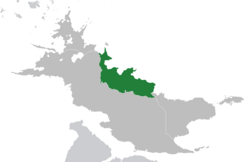Vidoria
This article is incomplete because it is pending further input from participants, or it is a work-in-progress by one author. Please comment on this article's talk page to share your input, comments and questions. Note: To contribute to this article, you may need to seek help from the author(s) of this page. |
Confederacy Of Vidoria Confederación Vidora | |
|---|---|
| Anthem: "Donde Crecen Todas Las Flores" "Where All The Flowers Grow" | |
 Location of Vidoria (dark green) – in Rennekka (dark grey) | |
| Capital | Aljuá |
| Largest city | Sejoría |
| Official languages | Veleazan |
| Demonym(s) | Vidorian |
| Government | Confederal Directorial Democratic Republic |
| History | |
• XXX | XXX |
• Colonisation by Veleaz | 1463 |
• Independence | August 1st 1899 |
| Area | |
• Total | 1,488,827 km2 (574,839 sq mi) |
• Water (%) | 5.1% |
| Population | |
• 2014 census | 60,543,234 |
• Density | 40.66/km2 (105.3/sq mi) |
| GDP (PPP) | estimate |
• Total | $2,132,998,677,054 |
• Per capita | $35,231 |
| GDP (nominal) | estimate |
• Total | $2,283,085,354,140 |
• Per capita | $37,710 |
| Gini (2014) | 29.2 low |
| HDI (2014) | 0.896 very high |
| Currency | Pessa (Ᵽ) (PSA) |
| Time zone | UTC -4 |
| Date format | dd-mm-yyyy |
| Driving side | left |
| Calling code | +11 |
| Internet TLD | .vd |
Vidoria (/vɪ'dʼɔ:ɹiə/; Veleazan Vidoría [biðo'ɾi.a]), officially the Confederacy Of Vidoria (Veleazan Confederación Vidora /konfeðeɾaˈθjon bi'ðoɾa/), is a country and confederacy in north Rennekka, in Aeia. The country is bordered by Renneque to the east, XXX to the south and Liberimery to the west. Its capital is Aljuá, on the Idovira Peninsula, and its most populated and largest city is Sejoría. The nation has a largely tropical climate, with higher temperatures in the south-east of the country the majority of the year. Vidoria is made up of 34 provinces of varying size and the two autonomous cities of Aljuá and Sejoría. With an area of 1,488,827km², Vidoria is the second largest country in Rennekka by land area, second only to Renneque. Due to its location, and its power within the continent, it is commonly referred to as 'the heart of Rennekka'.
Vidoria was inhabited by many tribal nations prior to its discovery by Manolo Luppi, and it's subsequent colonisation by Veleaz in 1463. Vidoria remained a colony of the Veleazan Empire until 1899, when Veleaz granted independence at the end of GW1 as a way to prevent the allies from getting possession of the colonies it possessed. The land that Veleaz possessed in Rennekka formed the Republic of Vidoria, a unitary state governed under an autocratic government and a dictator. This was dissolved after the Vidorian Uprising, with the ratification of the second constitution leading to the formation of the bicameral legislature and the adoption of the directorial system.
Vidoria's rise to global power did not occur until the mid-to-late 20th century, when the economy of the nation developed rapidly due to the dissolution of the First Republic and the increase in demand of the automotive and electronics industries. In the modern era, Vidoria is one of the most developed nations in Aeia, being part of the G20 and having one of the highest HDI rankings in Aeia, at 0.896. It is one of the largest wine producing nations in Aeia, primarily due to wine being a very key part of Vidorian culture as a whole. Vidoria is one of the leading members of XXX, an organization consisting of members... TBD
Etymology
The description of the country by the name Vidoria has been found on a Veleazan map from c.1490.
It is widely believed that the name Vidoria originates from the term the Caykarí people used to refer to the eastern part of the country. There are several interpretations, including "rich plains" ("plains of atl" (vied oríatl), with atl believed to be a common noun that refers to any precious metal). The name could also refer to an extinct wild wolf species called vidórea (Canis cunilucus), that is believed to have resided in the banks of the Baltas river.
During the late colonial period (c.1790-1899), western Vidoria (which was a separate entity from eastern Vidoria up until independence) was referred to as Territorios De Paraja (the Paraja Territories). This name comes from Allán Paraja, a Vidorian politician that had authority over the western parts of the colony from 1777 until his death in 1836. This name was used to refer to the western part of the country up until the early 1950's, when it was revealed that Allán Paraja had caused the genocide of the Esk'quári people, a large people group that inhabited much of Vidoria until the early-to-mid-1800's.
History
- Main article: History of Vidoria
Prehistoric
Colonial Period
20th Century to Present Day
Geography
Climate
Politics
Provinces
Economy
Demographics
Language
Urbanisation
Largest cities or towns in Vidoria
2014 census | |||||||||
|---|---|---|---|---|---|---|---|---|---|
| Rank | Province | Pop. | Rank | Province | Pop. | ||||
 Sejoria  Adrogué |
1 | Sejoria | Gran Sejoria | 9,213,466 | 11 | Ziguria | TBD | 503,492 |  Vinazia  Viyamueva |
| 2 | Adrogué | TBD | 4,394,193 | 12 | Sonita | TBD | 491,350 | ||
| 3 | Vinazia | TBD | 2,543,982 | 13 | Garaima-y-Tempura | TBD | 482,412 | ||
| 4 | Viyamueva | TBD | 1,141,802 | 14 | Barsada | TBD | 421,359 | ||
| 5 | Filipela | TBD | 792,592 | 15 | Pejilon | TBD | 381,401 | ||
| 6 | Haválla | TBD | 721,942 | 16 | Balagoa | TBD | 353,294 | ||
| 7 | Olavada | TBD | 602,432 | 17 | Naquila | TBD | 348,130 | ||
| 8 | Aljuá | Aljuá | 601,076 | 18 | Somolaúla | TBD | 325,139 | ||
| 9 | Lira | TBD | 597,311 | 19 | San Juán | TBD | 289,350 | ||
| 10 | Marilona | TBD | 509,391 | 20 | Hassedé | TBD | 251,502 | ||


